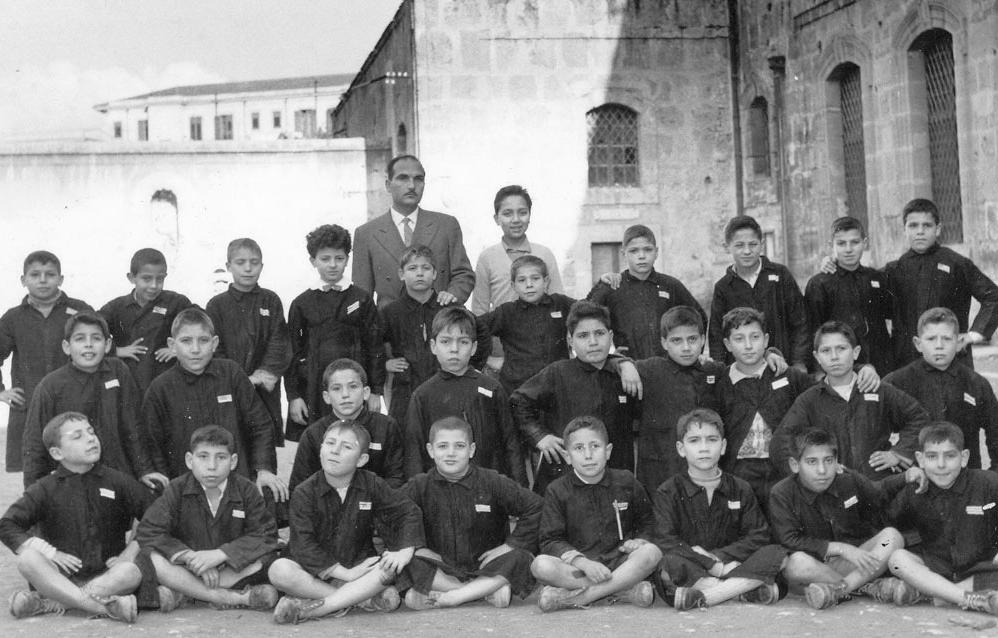
Italian Schools: Eras

Figure 1.-- Here we see an all boy elementary school class in Palermo on Sicily during 1958. It was the third year class (terza elementare). It is labeled 'caruso Francesco'. We are not sure what that meant. Francesco may refer to Franscicans. They have a secular teacher, but the building looks like a church building.
|
|
There are several different eras of Italian education. Until the 1860s, Italy was divided into several different independent states, including areas of northern Italy administered by the Austrians. Italy was unified in the 1860s under a monarchy and parlimentary democrcy. The democratic era ended in 1922-25 with the rise of Mussolini and his fascists. The Fascists were overthrown in 1943, but the NAZIs occupied much of Italy and established a Fascist state in northern Italy under Mussolini as a puppet figurhead. The German surrendeded in April 1945. The king abdicated in 1946 after a refornandum showed that opinion on the monarchy was divided. As a result, a new Italian Republic was created. The chool system in Italy was strongly affected by thes political developments.
Divided Italy
There are several different eras of Italian education. Until the 1860s, Italy was divided into several different independent states, including areas of northern Italy administered by the Austrians. This was at a time before public school systems were just begining to be founded. Italy and the rest of Catholic southern Europe lagged behinf Protestant northern Europe in the foundation of public schools. Northern Italy was somewhat different because areas were controlled by Austria.
Unified Italy: Monarchy and Parliamentary Democracy (1860-1925)
Italy was unified in the 1860s under a monarchy and parlimentary democrcy. We know very little about the 19th century at this time, but much more information is available on the 20th century.
The democratic era ended in 1922-25 with the rise of Mussolini and his fascists. Mussolini was appointd premier in 1922 and he estblished a dictatorship in 1925. Italy was the first Fascist government in Europe. The Fascists were overthrown in 1943, but the NAZIs occupied much of Italy and established a Fascist state in northern Italy under Mussolini as a puppet figurhead. The Fascists seized control of Italian education. Children wee subject to Fascist propaganda in every phse of their studies. Unlike Germany, however, the Fascist did not manage to completely control the country's education system. Children were exposed to Fascist symbols and taught to venerate Mussolini. The Church continued to be involved in the state schools and to operate many Catholic schools.
Republic (1946- )
The Germans surrendeded (April 1945). The king abdicated in 1946 after a refornandum showed that opinion on the monarchy was divided. As a result, a new Italian Republic was created. The school system in Italy was strongly affected by thes political developments. Perhaps even more important were economic developmnts. Italy, especially southern Italy, was a poor country. It is one reasion why so many Italians migrated to the United States and South America. Southern Europe was almost feudal as the social structure impeded development. In addition, the soil in the south was poor and exhausted. This was important in an economy that was largely agicultural. The country was devestated by Wirld War II which raged up the Peninsula as the llies drive the Germnd noth (1943-45). Recovery was a first slow. The German Economic Miracle, European integration, and the American Marshall Plan led to rapid economic growth and modernization. In just a few years, Italians were more prosperous than ever before the War. This of course had a major impact on education. TheGoverment had the money to invest in schools and families no longer needed the kids to help support the family.
HBC-SU

Related Chronolgy Pages in the Boys' Historical Web Site
[Main Chronology Page]
[The 1900s]
[The 1910s]
[The 1920s]
[The 1930s]
[The 1940s]
[The 1950s]
[The 1960s]
[The 1970s]
Navigate the Relate Boys Historical Clothing Style Pages
[Main country page]
[Long pants suits]
[Short pants suits]
[Lederhosen]
[Kneesocks]
[Eton suits]
[Jacket and trousers]
[Blazer
[School sandals]
Navigate the Boys' Historical Clothing School Uniform Pages
[Return to the Main Italian school page]
[Return to the Main School Uniform Page]
[Return to the Main School Uniform national page]
[Australia]
[England]
[France]
[Germany]
[Ireland]
[Japan]
[New Zealand]
[Scotland]
[United States]
Navigate the HBC School Section:
[About Us]
[Activities]
[Chronology]
[Clothing styles]
[Countries]
[Debate]
[Economics]
[Garment]
[Gender]
[Hair]
[History]
[Home trends]
[Literary characters]
[School types]
[Significance]
[Transport and travel
[Uniform regulations]
[Year level]
[Other topics]
[Images]
[Links]
[Registration]
[Tools]
[Return to the Historic Boys' School Home]
>br>
Created: Ocober 3, 2003
Last updated: 8:05 AM 4/16/2018




